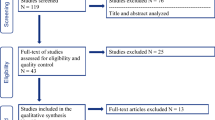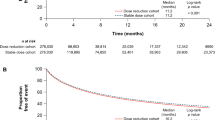Abstract
Background
The goal of this study was to examine national trends in hospitalization, emergency department (ED) utilization, secondary diagnoses, and charges associated with pediatric urolithiasis.
Methods
Data were evaluated from the Kids’ Inpatient Database of the Healthcare Costs and Utilization Project (HCUP) database from 1997 to 2012 and the HCUP National ED Sample from 2006 to 2011.
Results
Pediatric nephrolithiasis discharges increased by 18 %, while ureterolithiasis discharges decreased by 17 %. Hospital charges increased by 20 % when accounting for inflation, despite an overall decrease in discharges by 2.5 %. Female patients and those aged 15–17 years were more commonly affected. Pediatric ED visits increased by 9 %. The most common secondary diagnoses during 2003–2009 were urinary tract infections (UTI) (13 %), asthma (9 %), epilepsy (4 %), and paralysis (4 %).
Conclusions
Decreased hospitalizations and increased ED visits indicate a shift to outpatient care. Inpatient health care charges associated with pediatric urolithiasis continue to rise. Comorbidities include UTI, asthma, epilepsy, attention deficit hyperactivity disorder (ADHD), and mood disorders. Because of the significant health care burden and the increased risk to children of developing long-term sequelae there is a strong need for increased research into the mechanism of this systemic inflammatory disease and improved therapeutic targets.
Access this article
We’re sorry, something doesn't seem to be working properly.
Please try refreshing the page. If that doesn't work, please contact support so we can address the problem.



Similar content being viewed by others
References
Moe OW (2006) Kidney stones: pathophysiology and medical management. Lancet 367:333–344
Coe FL, Parks JH, Asplin JR (1992) The pathogenesis and treatment of kidney stones. N Engl J Med 327:1141–1152
Scales CD Jr, Curtis LH, Norris RD, Springhart WP, Sur RL, Schulman KA, Preminger GM (2007) Changing gender prevalence of stone disease. J Urol 177:979–982
Lotan Y (2009) Economics and cost of care of stone disease. Adv Chronic Kidney Dis 16:5–10
Sas DJ, Hulsey TC, Shatat IF, Orak JK (2010) Increasing incidence of kidney stones in children evaluated in the emergency department. J Pediatr 157:132–137
Bush NC, Xu L, Brown BJ, Holzer MS, Gingrich A, Schuler B, Tong LY, Baker LA (2010) Hospitalizations for pediatric stone disease in United States, 2002–2007. J Urol 183:1151–1156
Routh JC, Graham DA, Nelson CP (2010) Epidemiological trends in pediatric urolithiasis at United States freestanding pediatric hospitals. J Urol 184:1100–1104
Matlaga BR, Schaeffer AJ, Novak TE, Trock BJ (2010) Epidemiologic insights into pediatric kidney stone disease. Urol Res 38:453–457
Pearle MS, Calhoun EA, Curhan GC (2005) Urologic diseases in America project: urolithiasis. J Urol 173:848–857
Gillen DL, Worcester EM, Coe FL (2005) Decreased renal function among adults with a history of nephrolithiasis: a study of NHANES III. Kidney Int 67:685–690
Liu Y, Li S, Zeng Z, Wang J, Xie L, Li T, He Y, Qin X, Zhao J (2014) Kidney stones and cardiovascular risk: a meta-analysis of cohort studies. Am J Kidney Dis 64:402–410
Rule AD, Bergstralh EJ, Melton LJ 3rd, Li X, Weaver AL, Lieske JC (2009) Kidney stones and the risk for chronic kidney disease. Clin J Am Soc Nephrol 4:804–811
Rule AD, Roger VL, Melton LJ 3rd, Bergstralh EJ, Li X, Peyser PA, Krambeck AE, Lieske JC (2010) Kidney stones associate with increased risk for myocardial infarction. J Am Soc Nephrol 21:1641–1644
Schaeffer AJ, Feng Z, Trock BJ, Mathews RI, Neu AM, Gearhart JP, Matlaga BR (2011) Medical comorbidities associated with pediatric kidney stone disease. Urology 77:195–199
Novak TE, Lakshmanan Y, Trock BJ, Gearhart JP, Matlaga BR (2009) Sex prevalence of pediatric kidney stone disease in the United States: an epidemiologic investigation. Urology 74:104–107
Obligado SH, Goldfarb DS (2008) The association of nephrolithiasis with hypertension and obesity: a review. Am J Hypertens 21:257–264
Flegal KM, Tabak CJ, Ogden CL (2006) Overweight in children: definitions and interpretation. Health Educ Res 21:755–760
Kokorowski PJ, Routh JC, Hubert KC, Graham DA, Nelson CP (2012) Association of urolithiasis with systemic conditions among pediatric patients at children’s hospitals. J Urol 188:1618–1622
Taylor EN, Stampfer MJ, Curhan GC (2005) Obesity, weight gain, and the risk of kidney stones. JAMA 293:455–462
Heller HJ, Sakhaee K, Moe OW, Pak CY (2002) Etiological role of estrogen status in renal stone formation. J Urol 168:1923–1927
Bergsland KJ, Kinder JM, Asplin JR, Coe BJ, Coe FL (2002) Influence of gender and age on calcium oxalate crystal growth inhibition by urine from relatives of stone forming patients. J Urol 167:2372–2376
Pietrow PK, Pope JCT, Adams MC, Shyr Y, Brock JW 3rd (2002) Clinical outcome of pediatric stone disease. J Urol 167:670–673
Borghi L, Nouvenne A, Meschi T (2012) Nephrolithiasis and urinary tract infections: ‘the chicken or the egg’ dilemma? Nephrol Dial Transplant 27:3982–3984
Welch BJ, Graybeal D, Moe OW, Maalouf NM, Sakhaee K (2006) Biochemical and stone-risk profiles with topiramate treatment. Am J Kidney Dis 48:555–563
Corbin Bush N, Twombley K, Ahn J, Oliveira C, Arnold S, Maalouf NM, Sakhaee K (2013) Prevalence and spot urine risk factors for renal stones in children taking topiramate. J Pediatr Urol 9:884–889
Israni RK, Kasbekar N, Haynes K, Berns JS (2006) Use of antiepileptic drugs in patients with kidney disease. Semin Dial 19:408–416
Sampath A, Kossoff EH, Furth SL, Pyzik PL, Vining EP (2007) Kidney stones and the ketogenic diet: risk factors and prevention. J Child Neurol 22:375–378
Furth SL, Casey JC, Pyzik PL, Neu AM, Docimo SG, Vining EP, Freeman JM, Fivush BA (2000) Risk factors for urolithiasis in children on the ketogenic diet. Pediatr Nephrol 15:125–128
Stewart AF, Adler M, Byers CM, Segre GV, Broadus AE (1982) Calcium homeostasis in immobilization: an example of resorptive hypercalciuria. N Engl J Med 306:1136–1140
Craven BL, Passman C, Assimos DG (2008) Hypercalcemic states associated with nephrolithiasis. Rev Urol 10:218–226
Cury DB, Moss AC, Schor N (2013) Nephrolithiasis in patients with inflammatory bowel disease in the community. Int J Nephrol Renovasc Dis 6:139–142
Clark JH, Fitzgerald JF, Bergstein JM (1985) Nephrolithiasis in childhood inflammatory bowel disease. J Pediatr Gastroenterol Nutr 4:829–834
Lieske JC, de la Vega LS, Gettman MT, Slezak JM, Bergstralh EJ, Melton LJ 3rd, Leibson CL (2006) Diabetes mellitus and the risk of urinary tract stones: a population-based case-control study. Am J Kidney Dis 48:897–904
Taylor EN, Stampfer MJ, Curhan GC (2005) Diabetes mellitus and the risk of nephrolithiasis. Kidney Int 68:1230–1235
Faggiano A, Pivonello R, Melis D, Filippella M, Di Somma C, Petretta M, Lombardi G, Colao A (2003) Nephrolithiasis in Cushing’s disease: prevalence, etiopathogenesis, and modification after disease cure. J Clin Endocrinol Metab 88:2076–2080
Danese S, Semeraro S, Papa A, Roberto I, Scaldaferri F, Fedeli G, Gasbarrini G, Gasbarrini A (2005) Extraintestinal manifestations in inflammatory bowel disease. World J Gastroenterol 11:7227–7236
Soucie JM, Coates RJ, McClellan W, Austin H, Thun M (1996) Relation between geographic variability in kidney stones prevalence and risk factors for stones. Am J Epidemiol 143:487–495
Brikowski TH, Lotan Y, Pearle MS (2008) Climate-related increase in the prevalence of urolithiasis in the United States. Proc Natl Acad Sci U S A 105:9841–9846
Conflict of interest
The authors declare that they have no conflict of interest.
Author information
Authors and Affiliations
Corresponding author
Rights and permissions
About this article
Cite this article
Kusumi, K., Becknell, B. & Schwaderer, A. Trends in pediatric urolithiasis: patient characteristics, associated diagnoses, and financial burden. Pediatr Nephrol 30, 805–810 (2015). https://doi.org/10.1007/s00467-014-3012-3
Received:
Revised:
Accepted:
Published:
Issue Date:
DOI: https://doi.org/10.1007/s00467-014-3012-3




